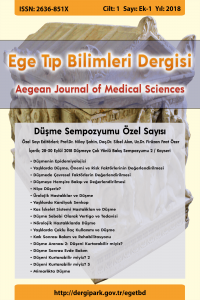Öz
Yaşlılarda
düşme sık karşılaşılan ve önemli bir sağlık sorunudur. Kırıklar, düşme korkusu,
mobilitede azalma ve bağımlılık ile kurumsal bakıma ihtiyaç duyma gibi olumsuz
sonuçlara yol açar. Hastalarda genellikle birden fazla risk faktörü birlikte
bulunur, bunlar arasında alt ekstremitede güçsüzlük, düşme hikayesi, yürüme ve
denge sorunları, tıbbi sorunlar, fonksiyonel bozukluklar, görme sorunları,
polifarmasi ve kognitif bozukluk sayılabilir. Hekimler toplum içinde yaşayan,
hastanede yatan veya bakımevlerinde bulunan tüm yaşlılarda düşme risk
faktörlerini tarama ve değerlendirmenin önemini bilmelidir. Tüm yaşlılara
tarama amacıyla son bir yıl içinde düşüp düşmediği sorulmalıdır. Düşme
nedenlerini belirlemede kapsamlı geriatrik değerlendirme oldukça yararlıdır;
böylece düşme hikayesi öğrenilir, tıbbi sorunlar değerlendirilir, ayrıntılı bir
ilaç anamnezi alınır, fizik muayene, ilgili laboratuvar testleri ve
görüntülemeler yapılır, çevresel faktörler değerlendirilir.
Falls in older people:
importance, and risk assessment
Falls in older people are a common and serious
health problem with devastating consequences including fractures, fear of
falling, reduced mobility and dependcency, and need for institutional care.
Risk factors for falls are often multifactorial
and include lower limb weakness, history of falls, gait or balance disorders,
medical problems, functional impairment, visual deficits, polypharmacy, and cognitive
impairment. The clinicians must be aware of
appropriate fall risk screens and assessments for community, hospital, and
residential aged care settings. All older
adults should be screened for "falls in the past year" by the
clinician. Comprehensive geriatric assessment that includes history of
falls, evaluation of medical comorbidities, medication review; physical
examination, relevant laboratory and imaging investigations, and environmental
surveillance, is likely to identify the reasons for falls.
Key words: Falls,
risk factors, geriatric assessment
Anahtar Kelimeler
Kaynakça
- 1. Masud T, Morris RO. Epidemiology of falls. Age Ageing 2001;30(Suppl 4):3–7.
- 2. Fleming J, Brayne C. Inability to get up after falling, subsequent time on floor, and summoning help: prospective cohort study in people over 90. BMJ 2008;337:a2227.
- 3. Cummings SR, Melton LJ. Epidemiology and outcomes of osteoporotic fractures. Lancet 2002;359:1761–1767.
- 4. Sattui SE, Saag KG. Fracture mortality: associations with epidemiology and osteoporosis treatment. Nat Rev Endocrinol 2014;10:592–602.
- 5. Scheffer AC, Schuurmans MJ, van Dijk N, et al. Fear of falling: measurement strategy, prevalence, risk factors and consequences among older persons. Age Ageing 2008;37:19–24.
- 6. Lord SR. Falls. In: Halter JB, Ouslander JG, Studenski S, et al.(eds).Hazzard’s Geriatric Medicine and Gerontology. 7th ed. NewYork. McGraw Hill Education; 2017:1318-1333.
- 7. Khow KSF, Visvanathan R. Falls in the aging population. Clin Geriatr Med 2017;33:357–368.
- 8. Guralnik JM, Ferrucci L, Simonsick EM, et al. Lower-extremity function in persons over the age of 70 years as a predictor of subsequent disability. N Engl J Med 1995;332:556-561.
- 9. Guralnik JM, Ferrucci L, Pieper CF, et al. Lower extremity function and subsequent disability: consistency across studies, predictive models, and value of gait speed alone compared with the short physical performance battery. J Gerontol A Biol Sci Med Sci 2000; 55:M221-231.
- 10. de Rekeneire N, Visser M, Peila R, et al. Is a fall just a fall: correlates of falling in healthy older persons. The Health, Aging and Body Composition Study. J Am Geriatr Soc 2003; 51:841-846.
- 11. Doruk H, Naharcı Mİ. Yaşlılarda düşmeler. In: Işık AT, Eker E (eds). Geriatrik Geropsikiyatrik Aciller. 1st ed. Ankara;Som Kitap. 2009: 71-84.
- 12. Trahair LG, Horowitz M, Jones KL. Postprandial hypotension: a systematic review. J Am Med Dir Assoc 2014;15:394–409.
- 13. Sanders KM, Scott D, Ebeling PR. Vitamin D deficiency and its role in muscle bone interactions in the elderly. Curr Osteoporos Rep 2014;12:74–81.
- 14. Park SH. Tools for assessing fall risk in the elderly: a systematic review and meta-analysis. Aging Clin Exp Res 2018; 30:1–16.
Ayrıntılar
| Birincil Dil | Türkçe |
|---|---|
| Konular | İç Hastalıkları |
| Bölüm | Derleme |
| Yazarlar | |
| Yayımlanma Tarihi | 29 Aralık 2018 |
| Kabul Tarihi | 4 Aralık 2018 |
| Yayımlandığı Sayı | Yıl 2018 Düşmeye Çok Yönlü Bakış Sempozyumu ll Özel Sayısı |



